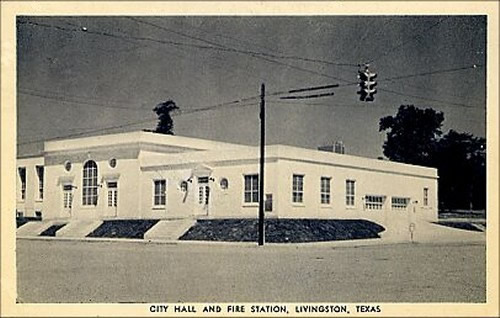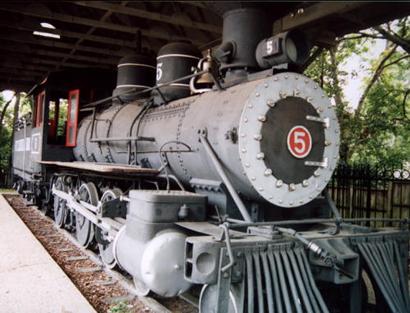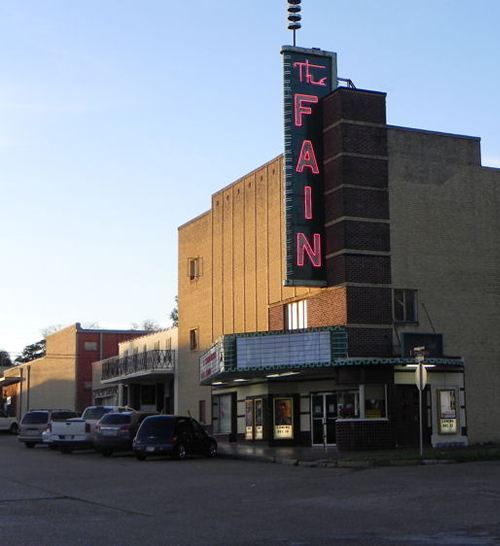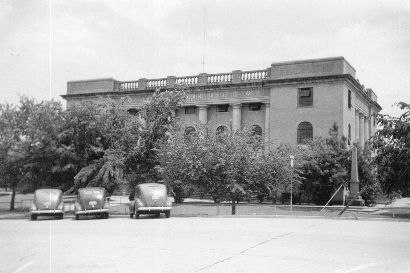Livingston, Texas, Polk County seat. (original) (raw)
History in a Pecan Shell
Known originally as Springfield in 1839, the town was renamed after Livingston, Tennessee, hometown of Moses Choate, the man who donated land for the townsite when Polk County was formed in 1846.
A brief timeline of selected Livingston events:
1902: Fire destroys much of downtown - town is incorporated
1917: Highway 35 (59) constructed
1932: Oil discovered 10 miles S of town
1936: City limits extended
1968: Lake Livingston is developed
Livingston population estimates:
1880: 135
1900: 1,024
1925: 900
1960: 3,300
1980: 5,000
1990: 5,019
2000: 5,433
2010: 5,344

Livingston City Hall and Fire Station, 1941
Postcard courtesy www.rootsweb.com/ %7Etxpstcrd/
Historical Marker:
LIVINGSTON
Seat of Polk County, founded in 1846; incorporated 1902. Named by Moses L. Choate, donor of its 100-acre townsite.
It became vital trade, educational and social center for people of sawmills and boat landings on the Trinity River. General Sam Houston was among guests dancing at Old Andress Inn in the early 1850s. The only Indian reservation in Texas, for the Alabama-Coushatta tribe, is located near here.
The economy is agricultural, based chiefly on ranching and timber. Since 1930 there has been major oil and gas development. Pine forest capital of Texas.
1966
Livingston, Texas
Landmarks & Attractions:
1939 Photo courtesy TxDoT

Locomotive No. 5
Photo courtesy Jim Evans, 2016
Historical Marker (on Heritage Park, W. Church and Drew St.)
Locomotive No. 5
Built in 1911 by Philadelphia's Baldwin Locomotive Works, this locomotive was first used to transport timber in Florida. In the 1920s, it was purchased for use in Texas' logging industry by the Angelina County-based Carter-Kelley Lumber Company. The locomotive traveled between Angelina and Polk County mill towns on Houston, East and West Texas Railway tracks, picking up logs and finished lumber that frequently had been hauled from local cutting areas by oxen. In use until 1952, the No. 5 contributed to the development of the area's timber industry.
1991


More Livingston Attractions:
- Lake Livingston
Camping, boating and fishing.
US 190, W of Livingston
936-365-2292 - Lake Livingston State Park
Camping, boating, fishing & horseback riding
936-365-2201
www.tpwd.state.tx.us - Alabama-Coushatta Indian Reservation
In the Big Thicket
Camping, fishing and swimming.
936-563-1100
www.alabama-coushatta.com - Jones Davis Cabin
Historic log cabin. Downtown.
530 W. Church St. - Polk County Museum
514 W. Mill St.
936-327-8192
www.livingston.net/museum
Native Daughter
- Tennessee Williams' Texas Director
by Bob Bowman ("All Things Historical" column)
Without the interest of an East Texas woman, American theater icon Tennessee Williams might still be writing high school plays in a small town.... At the time of her death in 1955, Margo Jones and Tennessee Williams had changed the face of theater not only in Texas, but nationally as well. Margo was buried in her hometown cemetery at Livingston and on April 26 the Texas Historical Commission and Polk County Historical Commission placed a state marker on her grave. more
Birthplace of Margo Jones
Historical Marker
Photo courtesy Jim Evans, 2016
Historical Marker: 517 S. Washington, Livingston
Birthplace of Margo Jones
(1911-1955)
World-famed genius of drama. Won Broadway acclaim directing "The Glass Menagerie." Led move to decentralize American theatre. Established, in Dallas, theatre-in-the-round (first professional, resident, repertory theatre of its kind) and wrote book on its technique. Premiered 58 new plays. Discovered Tennessee Williams, William Inge and others. A dedicated "artistic humanist," she provided channels through which the spiritual qualities of creative people could be communicated.
1967
Livingston, Texas Forum
- Subject: The historical marker for Birthplace of Margo Jones.
Today it's an empty lot, when I was growing up (long long ago) the house was there. She was probably the most famous person to come from Livingston. - Jim Evans, December 08, 2016 - Subject: Livingston Texas Election Night
Back in the early 50s' when I was quite young, I remember going to the courthouse on election day, and watching them put the election results on a large tote board. The reason for this was that not everyone had access to a television back then - especially poorer people. Election day (any election - local, state, or national) was a big thing then. It seemed everyone in the entire county was there discussing this and that about their favorite candidate, and some would get in fairly heated arguments. The merchants there in town loved it, as it was a time when the men would bring their wives, and they would shop in the stores there in downtown Livingston. During National elections, people would stay around the courthouse 'til quite late - waiting to find out who won the election. Respectfully, Thomas R. McIntyre, March 10, 2006 - There is one interesting fact that seldom makes the rounds when people talk of Livingston; and that is that the first golf course for Livingston was on my grand father's farm which was just north of Livingston, about 2 1/2 miles north on old Hwy. 35. Such early luminaries of the city of Livingston such as Mr. Gerlac, Mr. H.B. Davis and various and a sundry other folks would go there to play a round or two of golf. My father A.J. McIntyre would caddy for them. This was some time in the mid 1930s.
Also if you can get some of the older generation of indians to tell you about it, my grand father would hire them and pay them what was then a decent wage to work on his farm. He would send my uncle Thomas to the reservation to pick them up late on Sunday, and had a place for them to stay the week. He then would drive them back to the reservation on Friday night. This was a time when no one would hire an Indian, but he did! - Thomas Mcintyre, March 06, 2006
Texas Escapes, in its purpose to preserve historic, endangered and vanishing Texas, asks that anyone wishing to share their local history, stories, landmarks and recent or vintage photos, please contact us.

